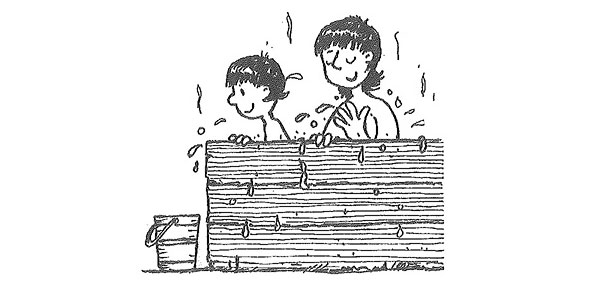by Dell Nakayama Uchida, For the North American Post
When I was a little girl, Papa took us to the “ofuro” (Japanese bath) similar to the “haku-jin’s” (white people) Saturday night baths. Only ours was on Sunday.
We didn’t have a tub at home so we would go to the public bathhouses at least once a week. Practical reasons aside, the “ofuro” was also a “nihon-jin” thing. Unlike the practice in Japan, the Americanized version was segregated by sex.
There were four ofuros in the Seattle Chinatown area- Shimoji and the Hinode were a couple. We moved to East First Street and mostly went to the Hashidate, under the old NP Hotel on 6th Avenue. We went down the stairs, into the office lobby, where we paid and they gave us a towel.
The left side housed the men’s side and the right, for women. When I was eight, my mother returned to Japan where she later died. My father took me into the men’s side until I was about ten years old. It was never crowded and I didn’t think anything about it because no one made an issue about a nude body. Soon, I graduated to the women’s side.
We changed in one room with a nice rug. Then we went to another room with wooden floors. Here, we scrubbed ourselves with a scrubber that had a cloth on the back with a loofa -like sponge on the front.
We scooped water from the big tub with a bucket to rinse ourselves. After we were thoroughly scrubbed and rinsed off, we climbed into the big, steaming, tub about the size of a double hot tub. We stayed in and soaked from 15 to 20 minutes.
The water was so hot, I didn’t see how any germs could exist. There was a fan running all the time where we dressed. It kept the steam down, but was rather chilly.
Often, when older boys belonging to athletic teams came, I could hear all this noise they made. There was a wall between the men and women’s side, but you could hear everything. Perhaps the baths were a substitute for showers and helped relax their muscles after the game.
After the bath, we sometimes went to the chambara (samurai) movies at the old Atlas Theater. They had comic cartoons in between the movies. We loved that.
In 1992, the late Mrs. Uchida and her husband, Jack, were among the six Seattle-area Nisei who began gathering each Monday to write their memoirs. This was the start of today’s Omoide (Memories) writing program. Others were Sam and Dee Goto, Margaret Yasuda, and Chuck Kato. Dee Goto is the sole survivor of the group and still directs the program today.







